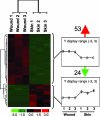Transcriptome-wide analysis of blood vessels laser captured from human skin and chronic wound-edge tissue
- PMID: 17728400
- PMCID: PMC1964861
- DOI: 10.1073/pnas.0706793104
Transcriptome-wide analysis of blood vessels laser captured from human skin and chronic wound-edge tissue
Abstract
Chronic wounds represent a substantial public health problem. The development of tools that would enable sophisticated scrutiny of clinical wound tissue material is highly desirable. This work presents evidence enabling rapid specific identification and laser capture of blood vessels from human tissue in a manner which lends itself to successful high-density (U133A) microarray analysis. Such screening of transcriptome followed by real-time PCR and immunohistochemical verification of candidate genes and their corresponding products were performed by using 3 mm biopsies. Of the 18,400 transcripts and variants screened, a focused set of 53 up-regulated and 24 down-regulated genes were noted in wound-derived blood vessels compared with blood vessels from intact human skin. The mean abundance of periostin in wound-site blood vessels was 96-fold higher. Periostin is known to be induced in response to vascular injury and its expression is associated with smooth muscle cell differentiation in vitro and promotes cell migration. Forty-fold higher expression of heparan sulfate 6-O-endosulfatase1 (Sulf1) was noted in wound-site vessels. Sulf1 has been recently recognized to be anti-angiogenic. During embryonic vasculogenesis, CD24 expression is down-regulated in human embryonic stem cells. Wound-site vessels had lower CD24 expression. The findings of this work provide a unique opportunity to appreciate the striking contrast in the transcriptome composition in blood vessels collected from the intact skin and from the wound-edge tissue. Sets of genes with known vascular functions but never connected to wound healing were identified to be differentially expressed in wound-derived blood vessels paving the way for innovative clinically relevant hypotheses.
Conflict of interest statement
The authors declare no conflict of interest.
Figures






Similar articles
-
Characterization of the acute temporal changes in excisional murine cutaneous wound inflammation by screening of the wound-edge transcriptome.Physiol Genomics. 2008 Jul 15;34(2):162-84. doi: 10.1152/physiolgenomics.00045.2008. Epub 2008 May 6. Physiol Genomics. 2008. PMID: 18460641 Free PMC article.
-
Positional differences in the wound transcriptome of skin and oral mucosa.BMC Genomics. 2010 Aug 12;11:471. doi: 10.1186/1471-2164-11-471. BMC Genomics. 2010. PMID: 20704739 Free PMC article.
-
Delayed wound repair and impaired angiogenesis in mice lacking syndecan-4.J Clin Invest. 2001 Jan;107(2):R9-R14. doi: 10.1172/JCI10559. J Clin Invest. 2001. PMID: 11160142 Free PMC article.
-
Catecholamines in the regulation of angiogenesis in cutaneous wound healing.FASEB J. 2020 Nov;34(11):14093-14102. doi: 10.1096/fj.202001701R. Epub 2020 Sep 19. FASEB J. 2020. PMID: 32949437 Free PMC article. Review.
-
Periostin in skin tissue and skin-related diseases.Allergol Int. 2014 Jun;63(2):161-70. doi: 10.2332/allergolint.13-RAI-0685. Epub 2014 Apr 25. Allergol Int. 2014. PMID: 24759560 Review.
Cited by
-
Changes of anabolic processes at the cellular and molecular level in chronic wounds under topical negative pressure can be revealed by transcriptome analysis.J Cell Mol Med. 2011 Jul;15(7):1564-71. doi: 10.1111/j.1582-4934.2010.01147.x. J Cell Mol Med. 2011. PMID: 20716124 Free PMC article.
-
Platelet-rich fibrin matrix improves wound angiogenesis via inducing endothelial cell proliferation.Wound Repair Regen. 2011 Nov;19(6):753-66. doi: 10.1111/j.1524-475X.2011.00740.x. Wound Repair Regen. 2011. PMID: 22092846 Free PMC article.
-
Use of laser capture microdissection for the assessment of equine lamellar basal epithelial cell signalling in the early stages of laminitis.Equine Vet J. 2015 Jul;47(4):478-88. doi: 10.1111/evj.12283. Epub 2014 Aug 19. Equine Vet J. 2015. PMID: 24750316 Free PMC article.
-
Genetic manipulation of periostin expression in the heart does not affect myocyte content, cell cycle activity, or cardiac repair.Circ Res. 2009 Jan 2;104(1):e1-7. doi: 10.1161/CIRCRESAHA.108.188649. Epub 2008 Nov 26. Circ Res. 2009. PMID: 19038863 Free PMC article.
-
Thy-1 (CD90), Integrins and Syndecan 4 are Key Regulators of Skin Wound Healing.Front Cell Dev Biol. 2022 Feb 3;10:810474. doi: 10.3389/fcell.2022.810474. eCollection 2022. Front Cell Dev Biol. 2022. PMID: 35186924 Free PMC article. Review.
References
-
- Kuehn BM. Jama. 2007;297:938–939. - PubMed
-
- Sullivan TP, Eaglstein WH, Davis SC, Mertz P. Wound Repair Regen. 2001;9:66–76. - PubMed
-
- Kiecolt-Glaser JK, Marucha PT, Malarkey WB, Mercado AM, Glaser R. Lancet. 1995;346:1194–1196. - PubMed
-
- Zutt M, Haas E, Kruger U, Distler M, Neumann C. Dermatology. 2007;214:319–324. - PubMed
-
- Smith PC. Int J Low Extrem Wounds. 2006;5:160–168. - PubMed
Publication types
MeSH terms
Grants and funding
LinkOut - more resources
Full Text Sources
Other Literature Sources
Medical
Molecular Biology Databases

